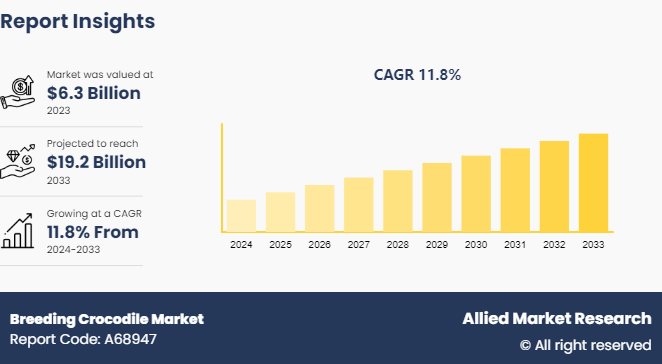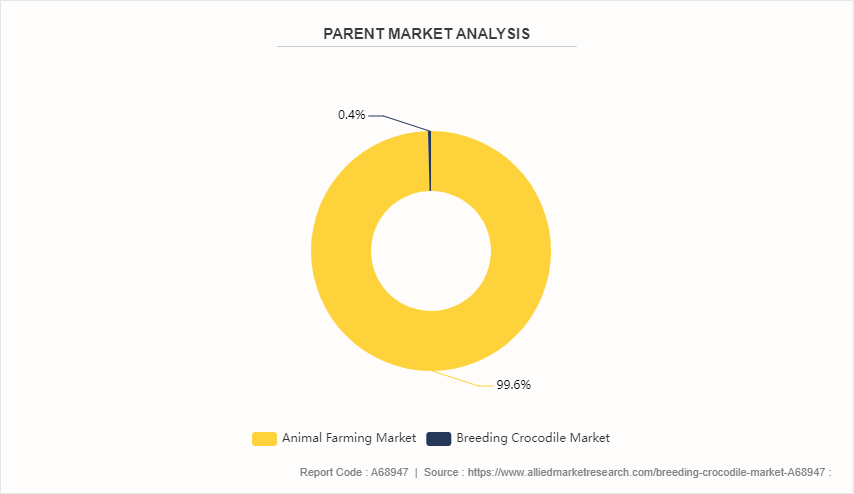Breeding Crocodile Market Research, 2033
Market Introduction and Definition
The global breeding crocodile market size was valued at $6.3 billion in 2023, and is projected to reach $19.2 billion by 2033, growing at a CAGR of 11.8% from 2024 to 2033. The breeding crocodile market includes regulated reproduction of crocodiles for commercial uses, such as leather, flesh, and byproducts like oil and bones. It includes every step of the process, from crocodile breeding and hatching to growing and harvesting. The market is driven by the growing interest in exotic meats among consumers and the need for premium crocodile leather, which is used in high-end fashion and accessories. Sustainable and controlled methods are critical to maintaining wild populations and adhering to international trade agreements such as CITES (Convention on International Trade in Endangered Species of Wild Fauna and Flora) in the market. Regulatory agencies, leather producers, and crocodile farms are important participants in the breeding crocodile market.

Key Takeaways
- The breeding crocodile market study covers 20 countries. The research includes a segment analysis of each country in terms of value for the projected period.
- More than 1, 500 product literature, industry releases, annual reports, and other such documents of major breeding crocodile industry participants along with authentic industry journals, trade associations' releases, and government websites have been reviewed for generating high-value industry insights.
- The study integrated high-quality data, professional opinions and analysis, and critical independent perspectives. The research approach is intended to provide a balanced view of global markets and to assist stakeholders in making educated decisions in order to achieve their most ambitious growth objectives.
Key market dynamics
The demand for premium crocodile leather, which is valued in the high-end fashion sector for its durability and distinctive texture, is the main factor propelling the breeding crocodile market growth. Crocodile leather is used by high-end fashion houses and accessory brands to make bags, shoes, belts, and other accessories. Furthermore, crocodile meat is becoming popular due to its increased nutritional value and status as a delicacy in several countries. In addition, many sectors, including cosmetics and traditional medicine, are using by-products such as crocodile oil and bones.
In addition, national and international laws aimed at ensuring ethical and sustainable business practices have a significant impact on the market. The trade in crocodile products is heavily regulated by the Convention on International Trade in Endangered Species of Wild Fauna and Flora (CITES) to prevent overexploitation. Market participants abide by these rules, which have an impact on how breeding operations are run and how products are shipped internationally. Countries that impose their standards for environmental preservation and animal welfare also have an impact on breeding techniques due to local legislation.
Furthermore, genetics, agricultural practices, and breeding technology advancements are increasing productivity and raising the caliber of crocodile products. Improvements in crocodile incubation, hatchery management, and feeding techniques have resulted in increased survival and improved growth rates. Furthermore, advances in tanning and processing methods for leather are improving the finished product' quality and increasing their demand in the luxury market.
However, the market has seen several obstacles despite its favorable drivers. High costs for running crocodile farm breeding, feeding, and maintenance can be a major barrier, especially for smaller companies. The industry is also vulnerable to diseases and environmental changes that may affect the health and death rates of crocodiles. In addition, animal rights organizations are becoming more scrutinous, which may have an impact on public opinion and commercial demand.
Thus, the breeding crocodile market is a dynamic and complex industry that is fueled by the need for high-end products, controlled by strict national and international laws, and advanced by technical developments. However, to maintain growth and profitability, it must overcome substantial obstacles to costs, environmental considerations, and ethical concerns.
Parent Market Overview of the Global Breeding Crocodile Market
The market for breeding crocodiles globally is a niche of the larger animal farming sector. The breeding and rearing of different exotic species to produce leather, meat, and byproducts is included in this parent market. The desire for distinctive and superior materials, especially in the luxury fashion business, is what propels the exotic farming sector. The strict international rules such as CITES have made sustainable and ethical farming techniques necessary. Technological developments in farming and breeding improve the output and quality of the final product. The industry is still expanding due to the great demand for and value of exotic animal products, despite obstacles like high operating costs, negative environmental effects, and ethical concerns.

Market Segmentation
The breeding crocodile market is segmented into type, application, and region. On the basis of type, the market is divided into Siamese crocodile, Thai crocodile, and others. On the basis of application, the market is divided into leather goods, food, medicine, and others. Region-wise, the market is analyzed across North America, Europe, Asia-Pacific, and LAMEA.
Regional/Country Market Outlook
The breeding crocodile market is dominated by the U.S., especially Florida and Louisiana. The well-known farms in the region, like St. Augustine Alligator Farm Zoological Park and Louisiana Alligator Farms, concentrate on both commercial breeding and conservation. The demand for premium crocodile leather, which is mainly utilized in the high-end fashion sector, drives the U.S. breeding crocodile market. Robust regulatory frameworks guarantee sustainable practices, thereby supporting the expansion of the market.
In addition, China's expanding middle class and rise in desire for exotic foods and high-end leather products are driving the country's rapid rise as a major market for breeding crocodile. Prominent companies, including Zhanjiang Pearl Bay Crocodile Farm, are growing their companies to fulfill the demands of both local and global markets. China's agricultural regulations are changing following international norms such as CITES, with a greater emphasis on ethical and sustainable farming methods. This market is expected to grow significantly, driven along by government programs aimed at promoting the exotic animal breeding sector.
Furthermore, the breeding crocodile market in Australia is well-established, with prominent companies such as Porosus Pty Ltd. at the forefront. The nation is an ideal location to raise crocodiles because of its exceptional environment and abundance of natural resources. Australian crocodile leather is highly sought after in the world's luxury market due to its reputation for quality. Developments in breeding technologies further improve market possibilities, and the sector is carefully controlled to ensure sustainability and animal welfare.
Moreover, Thailand is a major player in the breeding crocodile market forecast, driven by establishments like Samutprakarn Crocodile Farm and Zoo. Products made from crocodiles, such as leather, meat, and live animals, are heavily exported from the nation. Thailand's export network is strong and its infrastructure is well-established. The government has put regulations into place to support environmentally friendly farming methods, guaranteeing the industry's long-term survival.
In addition, Africa has expanded markets for breeding crocodile, especially in South Africa and Zimbabwe. These regions are advantageous for crocodile farming due to their natural habitats and mild climates. High-quality crocodile meat and leather exports are the main drivers of the sector. Regulatory frameworks are being strengthened in accordance with global norms to promote ethical and sustainable farming methods.
Thus, the global breeding crocodile market is broad, including important centers in the U.S., China, Australia, Thailand, and Africa. Rise in demand for exotic meats and high-end leather products propels growth in all regions, each with its advantages and challenges. Strict rules along with ethical and sustainable practices are critical to the market's sustained success and expansion.
Industry Trends:
- In June 2023, a new line of sustainable crocodile meat products was introduced by Crocodile Ventures in the U.S., with an eye toward fine dining establishments and specialty meat shops.
- In September 2023, China Crocodile Farming Corp announced business expansion to double their breeding capacity in response to the growing demand for crocodile products both domestically and internationally.
- In April 2023, Thailand's Bangkok Crocodile Products Ltd. increased exports with an eye toward the Middle East and Europe.
Competitive Landscape
The major players operating in the breeding crocodile market share include Zhenshan Crocodile Culture, Zhenjiang Shunda, Guangdong Fulu, Linyi Xuri Crocodile Breeding, Koorana Crocodile Farm, Shandong Yurui, and Juncheng.
Recent Key Strategies and Developments
- In March 2023, Alligator Farms Inc. increased its capacity to provide premium crocodile leather to the fashion industry by growing their company to include a new breeding facility.
- In February 2023, Guangzhou Crocodile Breeders was acquired by Shanghai Exotic Leather Co. to strengthen its position as a top provider of crocodile leather.
Key Sources Referred
- Convention on International Trade in Endangered Species of Wild Fauna and Flora (CITES)
- Florida Alligator and Crocodile Farmers Association (FACFA)
- Louisiana Alligator Farmers and Ranchers Association (LAFRA)
- Crocodile Farmers Association of the Northern Territory (CFANT)
- Australian Crocodile Traders Association (ACTA)
- Thai Crocodile Farmers Association (TCFA)
- South African Crocodile Breeders Association (SACBA)
- Zimbabwe Crocodile Farmers Association (ZCFA)
- China Leather Industry Association (CLIA)
Key Benefits For Stakeholders
- This report provides a quantitative analysis of the market segments, current trends, estimations, and dynamics of the breeding crocodile market analysis from 2024 to 2033 to identify the prevailing breeding crocodile market opportunities.
- The market research is offered along with information related to key drivers, restraints, and opportunities.
- Porter's five forces analysis highlights the potency of buyers and suppliers to enable stakeholders make profit-oriented business decisions and strengthen their supplier-buyer network.
- In-depth analysis of the breeding crocodile market segmentation assists to determine the prevailing market opportunities.
- Major countries in each region are mapped according to their revenue contribution to the global market.
- Market player positioning facilitates benchmarking and provides a clear understanding of the present position of the market players.
- The report includes the analysis of the regional as well as global breeding crocodile market trends, key players, market segments, application areas, and market growth strategies.
Breeding Crocodile Market Report Highlights
| Aspects | Details |
| Market Size By 2033 | USD 19.2 Billion |
| Growth Rate | CAGR of 11.8% |
| Forecast period | 2024 - 2033 |
| Report Pages | 250 |
| By Type |
|
| By Application |
|
| By Region |
|
| Key Market Players | Zhenshan Crocodile Culture, Zhenjiang Shunda, Guangdong Fulu, Koorana Crocodile Farm, Linyi Xuri Crocodile Breeding, Shandong Yurui, Juncheng |
Upcoming trends in the global breeding crocodile market include increased demand for sustainable farming practices, innovations in breeding technologies, expansion into emerging markets, and stricter regulations on wildlife trade.
The leading application of the Breeding Crocodile Market is for the production of high-quality leather, used in luxury goods such as handbags, shoes, and belts, and for crocodile meat consumption.
The largest regional market for breeding crocodiles is Asia-Pacific, primarily due to high demand for crocodile leather and meat, with countries like Thailand and Indonesia being major contributors.
The global breeding crocodile market was valued at $6.3 billion in 2023, and is projected to reach $19.2 billion by 2033, growing at a CAGR of 11.8% from 2024 to 2033.
The major players operating in the breeding crocodile market include Zhenshan Crocodile Culture, Zhenjiang Shunda, Guangdong Fulu, Linyi Xuri Crocodile Breeding, Koorana Crocodile Farm, Shandong Yurui, and Juncheng.
Loading Table Of Content...


